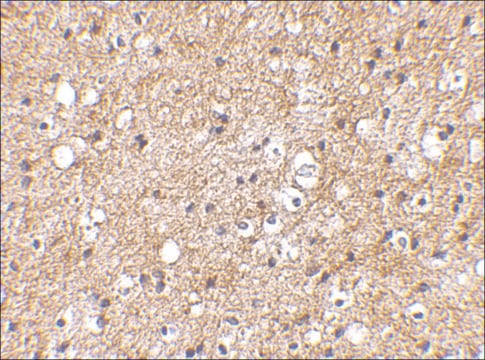PZ0115
CP-31398 dihydrochloride hydrate
≥98% (HPLC)
Sinônimo(s):
N′-[2-[2-(4-Methoxyphenyl)ethenyl]-4-quinazolinyl]-N,N-dimethyl-1,3-propanediamine dihydrochloride hydrate
About This Item
Produtos recomendados
Ensaio
≥98% (HPLC)
condição de armazenamento
desiccated
cor
yellow
solubilidade
H2O: ≥20 mg/mL
temperatura de armazenamento
2-8°C
cadeia de caracteres SMILES
O.Cl.Cl.COc1ccc(cc1)\C=C\c2nc(NCCCN(C)C)c3ccccc3n2
InChI
1S/C22H26N4O.2ClH.H2O/c1-26(2)16-6-15-23-22-19-7-4-5-8-20(19)24-21(25-22)14-11-17-9-12-18(27-3)13-10-17;;;/h4-5,7-14H,6,15-16H2,1-3H3,(H,23,24,25);2*1H;1H2/b14-11+;;;
chave InChI
JXIVIAMOMIONKY-UWCBQFGESA-N
Informações sobre genes
human ... TP53(7157)
mouse ... TP53(22059)
rat ... TP53(24842)
Aplicação
- to evaluate its effects on the upregulation of miRNA in human neuroblastoma cells
- to study its effects on arsenic trioxide (ATO) stabilization of p53 folding
- to study its effects on regulation of miR-34 in PC12 cells
Ações bioquímicas/fisiológicas
Características e benefícios
Palavra indicadora
Warning
Frases de perigo
Declarações de precaução
Classificações de perigo
Acute Tox. 4 Oral - Aquatic Chronic 4 - Eye Irrit. 2 - Skin Irrit. 2
Código de classe de armazenamento
11 - Combustible Solids
Classe de risco de água (WGK)
WGK 3
Ponto de fulgor (°F)
Not applicable
Ponto de fulgor (°C)
Not applicable
Certificados de análise (COA)
Busque Certificados de análise (COA) digitando o Número do Lote do produto. Os números de lote e remessa podem ser encontrados no rótulo de um produto após a palavra “Lot” ou “Batch”.
Já possui este produto?
Encontre a documentação dos produtos que você adquiriu recentemente na biblioteca de documentos.
Artigos
Cell cycle phases (G1, S, G2, M) regulate cell growth, DNA replication, and division in proliferating cells.
Apoptosis regulation involves multiple pathways and molecules for cellular homeostasis.
Nossa equipe de cientistas tem experiência em todas as áreas de pesquisa, incluindo Life Sciences, ciência de materiais, síntese química, cromatografia, química analítica e muitas outras.
Entre em contato com a assistência técnica![[Pyr1]-Apelin-13 trifluoroacetate salt ≥96% (HPLC)](/deepweb/assets/sigmaaldrich/product/images/391/809/a864cd5a-3260-42cf-93ae-cb4754f4e4ad/640/a864cd5a-3260-42cf-93ae-cb4754f4e4ad.jpg)









